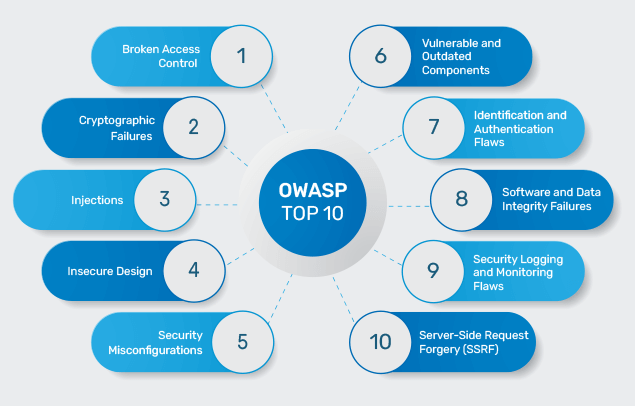
The OWASP (Open Web Application Security Project) Top 10 is a widely recognized list of the most critical web application security risks. It is updated every three years to reflect the current state of web application security and provide guidance for developers and security professionals.
In this blog, we will provide a breakdown of the OWASP Top 10 vulnerabilities and explain how to mitigate them.
Injection:
This occurs when an attacker is able to inject malicious code into a web application, allowing them to gain access to sensitive information or perform unauthorized actions. To mitigate injection risks, it’s important to use parameterized queries and prepared statements, and to validate all user input.
Broken Authentication and Session Management:
This vulnerability occurs when an attacker is able to gain unauthorized access to a web application by exploiting weak authentication or session management controls. To mitigate this risk, it’s important to use strong authentication and session management controls, such as two-factor authentication, and to protect session IDs with secure cookies.
Cross-Site Scripting (XSS):
This vulnerability occurs when an attacker is able to inject malicious scripts into a web page, allowing them to steal sensitive information or perform unauthorized actions. To mitigate XSS risks, it’s important to use output encoding and to validate all user input.
Insecure Direct Object References:
This vulnerability occurs when a web application references an internal object, such as a file or database record, using user-supplied input. To mitigate this risk, it’s important to use access controls and to validate all user input.
Security Misconfiguration:
This vulnerability occurs when a web application is not properly configured, leaving it open to attack. To mitigate this risk, it’s important to keep software up to date, use strong passwords, and to follow secure configuration guidelines.
Sensitive Data Discovery:
This vulnerability occurs when an attacker is able to discover sensitive information, such as credit card numbers or personal health information, stored on a web application. To mitigate this risk, it’s important to encrypt sensitive data and to use access controls.
Missing Function Level Access Control:
This vulnerability occurs when a web application does not properly restrict access to sensitive functionality. To mitigate this risk, it’s important to use access controls and to validate all user input.
Cross-Site Request Forgery (CSRF):
This vulnerability occurs when an attacker is able to perform actions on behalf of a user without their knowledge or consent. To mitigate this risk, it’s important to use anti-CSRF tokens and to validate all user input.
Using Components with Known Vulnerabilities:
This vulnerability occurs when a web application uses a component, such as a library or framework, that has known vulnerabilities. To mitigate this risk, it’s important to keep all components up to date and to use security-hardened versions when available.
Unvalidated Redirects and Forwards:
This vulnerability occurs when a web application redirects or forwards a user to an untrusted site without properly validating the destination. To mitigate this risk, it’s important to validate all redirects and forwards and to use anti-CSRF tokens.
It’s important to keep in mind that these vulnerabilities are not exhaustive, and that new risks are constantly emerging. Additionally, mitigation techniques may vary depending on the specific web application and its architecture. It is also important to test web applications regularly and to stay informed of new security threats and vulnerabilities.
In conclusion,
web application security is a constantly evolving field, and the OWASP Top 10 is a great starting point for understanding the most critical risks. By understanding these vulnerabilities and taking steps to mitigate them, organizations can protect their web applications












